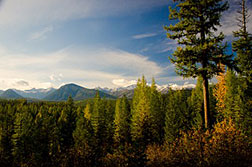- Number 434 |
- March 9, 2015
Even at high humidity, aerosols stick around

Research determined the evaporation rates
of secondary organic aerosols at elevated
relative humidity. The aerosol particles are
produced by natural and anthropogenic
sources. Photo credit: Scott Butner
Ubiquitous carbon-rich aerosol particles created by emissions from cars, trees, and other sources alter our climate and affect air quality. Until recently, the properties of these aerosols were hard to experimentally characterize, forcing computational models to rely on unsupported assumptions. For several years, scientists at DOE's Pacific Northwest National Laboratory have chipped away at these notions. They have provided hard data about viscosity, shape, morphology, volatility, and other fundamental particle properties. Recently, the team tackled how the particles, called secondary organic aerosol particles (SOA), evaporate when the relative humidity is high. They found that these aerosols actually evaporate very slowly, sticking around for days.
"Together, our studies of evaporation rates and viscosity provide incontrovertible experimental data that the assumptions invoked to model SOA formation and evolution are fundamentally flawed," said Dr. Alla Zelenyuk, the PNNL chemist who led the study.
Models have persistently and significantly underestimated atmospheric loadings of SOA. Similarly, simulations could not explain how aerosols carry pollutants thousands of miles away from the sources to pristine environments. The assumption that SOA quickly evaporated got in the way. The SOA were assumed to be at constant equilibrium with the gas phase through rapid evaporation or condensation and internal mixing. Now, scientists can add aerosols' fundamental properties into the models, opening the door to discover how the most abundant particulates in the atmosphere affect our climate and air quality.[Kristin Manke, 509.372.6011,
kristin.manke@pnnl.gov]
